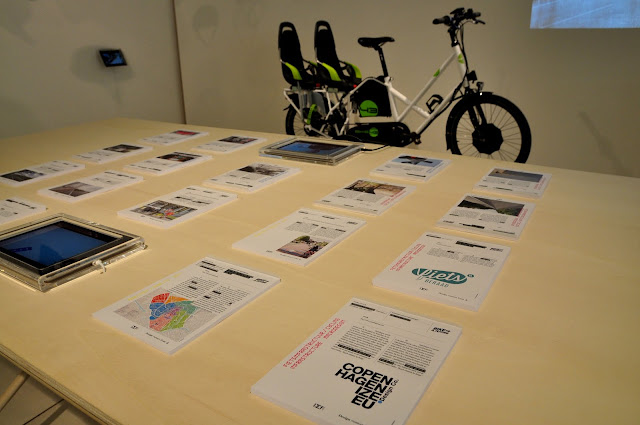
By Clotilde Imbert & James Thoem / Copenhagenize Design Company
This summer, Copenhagenize Design Co. is featured in three exhibitions dealing with bicycles, cycling, and urban transformations. Spend a day in Budapest (Hungary), Ghent (Belgium), and/or Paris (France) taking in some urban culture at an inspiring exhibition. What’s great to see is two of the venues hosting the exhibitions are in fact applied arts and design museums, only further showcasing the fact that the bicycle is back in the life of people through the angle of a daily object.
Here at Copenhagenize we always say that no textbook, no analytical software, no traffic model, can rival the value of just getting out there and observing the city and contemplating the role of bicycles in everyday transportation. We consider city streets to be the very best laboratory for urban innovation. Nevertheless, it's fantastic to see museums and galleries seizing the topic and showcasing it in a new environment.
Bikeology Cycling Exhibition, Museum of Applied Arts. Budapest, Hungary.
Photo: Mohai Balázs
Curated by Kultur Gorilla, Bikeology is an exhibition exploring contemporary design innovations in the field of cycling. It offers a positive vision of the future and explores the mobility paradigm shift on going. The exhibition illustrates the role and importance of design in urban cycling through a triple section of the individual, the local communities, and the global challenges.
The exhibition features one of our favourite early experiments, the Copenhagenize Love Handle.
Developed in 2010, the Copenhagenize Love Handle was prototyped in the urban theatre that is Copenhagen, Denmark. The aim of this product is simple, provide people travelling by bike the added comfort of having something to lean against while waiting at red light. It may not seem like much, but this added handle makes waiting at a red light just a little more comfortable, indirectly discouraging impatient cyclists from skipping through a red line. See it in action here.
Back in 2010, designing urban furniture for bicycle riders –beyond the simple bicycle rack- was a new phenomenon. Few cities had ever considered supporting bicycle riders in any infrastructural capacity beyond cycle tracks. To create a successful new product, a design approach is the key. Observe bicycle user behaviour and design appropriately.
Six years on we are proud to see our Love Handle in a museum, but most of all to spot more and more products for cyclists implemented in the streets.
Bike To The Future, Design Museum Ghent. Ghent, Belgium
Photo: Clotilde Imbert
The Design museum of Ghent, one of the most bicycle-friendly city in Belgium, is hosting Bike to the Future, an exhibition on bicycles and world-wild initiatives to promote cycling. We love the name, it almost sounds as if it could be a Copenhagenize conference!
This major exhibition in Belgium is playful and interactive. Race bikes, cargo-bikes, folding bikes, wooden bikes, all sorts of recent bicycles or prototypes are featured. After a visit, folks will probably feel like going to a bike shop to purchase their own steed. Well, mostly men and sporty cyclists could get this feeling, since an important part of the exhibition focuses on technical and technological innovations on bicycles, rather than on the simplicity of this old but timeless means of transportation, designed for men and women.
Videos, photographs, and numerous fact sheets allow the audience to get to know many initiatives related to cycling in town: from world-wild phenomena like Critical Mass (or Critical Miss?) and Cycle Hack, to the latest technologies allowing cyclists to find their, and to new items of bicycle urbanism from micro-design to macro-design.
Within this wide range the information, people can find an important number of trends launched first in Copenhagen : Copenhagenize, Cycle Chic (and Belgium Cycle Chic), The Slow Bicycle Movement, and CyclingWithout Age.
Mutations Urbaines: la ville est à nous!, Cité des sciences & de l’industrie. Paris, France
Photo: Darjelling
Cities must adapt themselves to countless dynamic factors from demographic increase, to new technologies, and climate change. Urban Planners often deal with these issues from behind their desks, while local inhabitants live them each and every day. As the city changes, so too do the behaviours and attitudes of everyday citizens, however small or large.
The curator of the exhibition has decided to highlight four cities that can inspire others to adapt their urban environment to the new reality: Copenhagen, Detroit, Songdo and Medellin are all an international leaders in a specific field.
A film screening showcases Copenhagen as a model of green city, which has prioritized pedestrians and cyclists over cars. Using Copenhagenize's photomontages of streets in 1973 and 2014, they explain that removing cars to make space for active mode of transportations like walking and cycling is achievable.
What’s more, further attention is turned to a now global movement that started in Copenhagen, Cycling Without Age. Started by our friend Ole Kassow, Cycling Without Age facilitates rickshaw rides for elderly living in nursing homes, reconnecting otherwise a relatively immobile group with their changing city.








